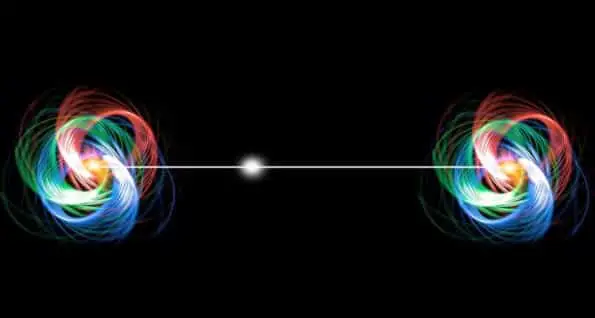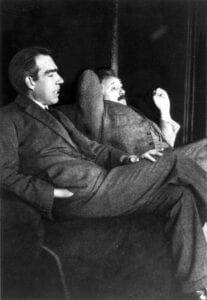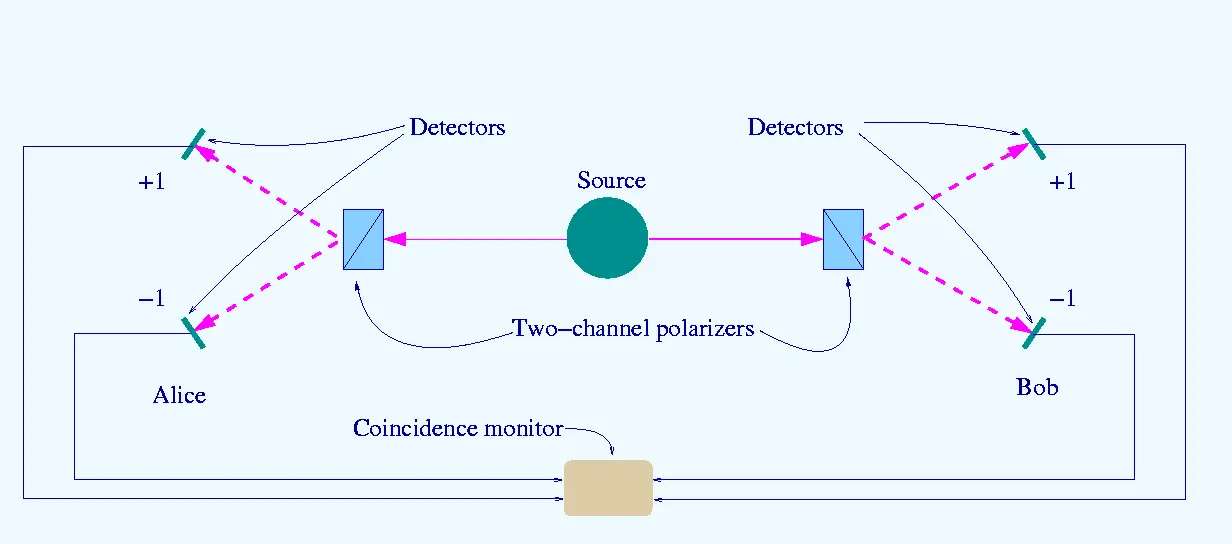EPR paradox – a thought experiment, that simply asks a question that Can Quantum-Mechanical Description of Physical Reality be Considered Complete? In other words, Albert Einstein – one of the authors of the EPR paper, refused to accept the principle of quantum indeterminacy.
In fact, in Einstein’s view, everything, whether quantum or classical should be deterministic in nature. Of course, not to mention, the whole of classical physics comes within the realm of determinism.
Therefore, with this in mind, Albert Einstein and two of his younger colleagues, Boris Podolsky and Nathan Rosen asked some fundamental questions regarding our understanding of reality.
In this article, I will try to give you a brief flashback on the Einstein Podolsky Rosen Paradox. In order to get a clear picture, stick with me till the end. Let’s start this journey to understand whether the EPR paradox is a thought, a myth, or simply a reality?
EPR Paradox – a Thought?

What is the EPR paradox anyway? Well, it’s a quantum paradox that directly questions the fundamental fabrics of quantum mechanical theory. A fabric – in the quantum mechanical world is known as the foundational interpretation of quantum mechanics. Not to mention, there are so many different interpretations of quantum mechanics.
Out of all, the Copenhagen interpretation of quantum mechanics is the widely accepted one. According to the Copenhagen interpretation, the concept of measuring position or momentum at the same time has no true physical meaning in nature.
An interpretation, now famously known as the Heisenberg Uncertainty principle. In other words, Quantum mechanics is indeterministic, or, you can say probabilistic in nature.
Check out, Wave-Particle Duality – Physical Reality of Quantum Physics
With this in mind, the thought of the EPR paradox surfaced in the conscience of Einstein. Simply because the idea that quantum mechanics is probabilistic, not deterministic, deeply bothered Einstein.
Copenhagen Interpretation of Quantum Mechanics

The formulation of quantum physics is based on two principal points. First, until the moment of measurement, a particle could be in multiple places at one time. Second, as soon as we measure the position of particle A; with simple mathematics, the position of particle B could be easily predicted. (Same goes for the momentum of a particle).
When you combine these two key points, what you get is the Copenhagen interpretation of quantum mechanics. Or in other words, you get the Heisenberg uncertainty principle.
Well, what basically I want to tell you is that according to the Copenhagen interpretation, the observation creates reality. This is where Einstein had issues.
In Einstein’s view, observation does not create reality, reality is itself fundamental. As once Max Planck said, and I quote,
I regard consciousness as fundamental. I regard matter as derivative from consciousness. We cannot get behind consciousness. Everything that we talk about, everything that we regard as existing, postulates consciousness.
Principle of Locality and Realism

According to the Copenhagen interpretation of quantum mechanics, as soon as we measure the position or momentum of particle A, the position or momentum of particle B could be easily predicted with certainty.
Therefore, for that to happen, the information has to be transferred faster than the speed of light, which is prohibited by the theory of relativity. Einstein termed this bizarre phenomenon as Spukhafte Fernwirkung or Spooky Action At a Distance.
In other words, not only the transfer of information will contradict the idea or principle of locality. It will also oppose the idea of realism. The idea of locality means that no physical effect could take place faster than the speed of the light.
On the other hand, the idea of realism means the observation does not create reality, reality is fundamental. In fact, the principle of locality has its roots in the classical world. In classical mechanics, the idea of locality is known as action at a distance.
And, when you combine these two, what you get is local realism. Or, in the words of Einstein Podolsky Rosen, you get the EPR paradox.
God Does Not Play Dice

As, the information is being able to transfer faster than the speed of light, therefore, as a result, quantum theory is non-local. Einstein suggested that there have to be some hidden elements which would make quantum theory local again. That’s why he theorized that quantum theory is incomplete.
In fact, Neil Bohr – The proprietor of Copenhagen’s interpretation, never challenged the fact that quantum physics is indeed showing non-locality. He just can’t accept that quantum theory has to be deterministic in nature, rather than being a probabilistic one.
And, with that, started the series of publicly heated debates between Albert Einstein and Neil Bohr, regarding the fundamental nature of reality.
In other to justify that quantum physics indeed complete, therefore, does not require local hidden variables; Bohr even wrote a paper with the same title just like the EPR paper.
After Bohr’s response, Einstein famously said that “God does not play dice”. Well, don’t think Bohr would lay down his guards. He responded to Einstein by advising him to “stop telling God what to do”.
Quantum mechanics is very worthy of regard. But an inner voice tells me that this is not yet the right track. The theory yields much, but it hardly brings us closer to the Old One’s secrets. I, in any case, am convinced that He does not play dice – Albert Einstein.
Concluding Remarks
Well, my concluding remark would be that the EPR paradox is an awesome thought experiment. I mean, even Neil Bohr acknowledged it. Okay, maybe partially, but he did. So, we have reached the point to check out the next goal of this article.
EPR Paradox – a Myth?
As a matter of fact, the way Einstein’s spooky theory was presented, was a bit confusing. I mean, even professional theoretical physicists were hesitant to even take a look.
Years later, American physicist and philosopher David Bohm developed an alternative approach to the EPR experiment.
EPR Paradox in Terms of Bohemian Mechanics
Unlike the position-momentum correlation calculation; according to bohemian mechanics or Bohm formulation, EPR Paradox can be explained in terms of electron-positron pairs. Not to mention, the way Bohm interpreted the EPR experiment was quite easy to understand.
Bohemian Way
Let’s take an example of an electron-positron pair in terms of spin-singlet. Suppose a decaying atom emits electron-positron pair in opposite directions.

As the momentum is conserved, the electron goes towards destination A, where there is an observer sitting named Alice. (See the above figure for proper understanding). Similarly, the positron goes towards destination B, where an observer is sitting named Bob.
Don’t forget both went in the opposite direction. Moreover, like the uncertainty principle or so-called Copenhagen interpretation of quantum mechanics states, “it is impossible to determine both the position and momentum of electron or positron precisely.
Nevertheless, it also states that if the exact momentum of the electron is known (of course, after the collapse of the wave function). Therefore, with the proper mathematical calculation, we can for sure determine the exact momentum of the positron.
Until the time of measurement, both electron and position can have multiple states. Simply because they are in entangled states or in a quantum superposition.
Case 1
As the electron went towards destination A, where Alice is taking the measurement. She will get the spin of an electron as (+x). Therefore, as a result, when bob will take the measurement, he will surely get the spin of the positron as (-x). Or, vice versa.
Case 2
Similarly, as the electron went towards destination A (this time in the perpendicular direction), Alice will get the spin of an electron as (+z). Therefore, as a result of the collapse of the wave function, Bob will definitely get the spin of the positron as (-z). Or, vice versa.
Case 3 (take away point)
Again, the electron went towards destination A and the positron went towards destination B. If Alice and Bob are taking measurements along X-axis, they will definitely get the result as expected in Case 1. Likewise, if Alice and Bob are taking measurements along Z-axis, they will unquestionably get the result as expected as Case 2.
Now suppose, if Alice is taking measurement along X-axis, therefore get the result as (+x) or (-x). Here comes the catch. What if Bob takes his measurement along Z-axis, rather than taking measurements along X-axis?
Uncertainty Fails

Yup, you heard me right. According to the quantum indeterminacy or uncertainty principle, the position-momentum complementarity only applies to the measurement taken in opposite direction.
In other words, if both Alice and Bob are taking measurements along the same axis but in opposite direction, they both will get their answer in terms of the Uncertainty principle.
On the other hand, if Alice is taking measurement along X-axis and Bob is taking measurement along Z-axis. It doesn’t matter what spin value (in terms of x) Alice got during her measurement. When Bob will take his measurement along Z-axis, he will have 50-50 chances of having either (+z) or (-z).
Recommended, Top 6 game-changing facts about quantum mechanics you never knew
To put it differently, Bob’s positron will have a definite spin value, only and only if, when measured along the same axis as Alice’s electron. On the contrary, when measured along a perpendicular axis i.e Z-axis, Bob’s Positron spin will be uniformly random.
Concluding Remarks
As you can see from the above case study (especially case 3), in order to determine the spin of the positron (Bob), information (from Alice) has to be transferred faster than the speed of light. Therefore, there is a definite need for a hidden variable to account for this Non-locality to make Quantum physics local again.
As far as Einstein’s spooky theory or EPR Paradox is concerned, you can say that Bohm’s formulation is nothing but the extension of the EPR Paradox. I mean, you can see that Case 1 and 2 are almost the same as the EPR example.
Therefore, my concluding remarks will be that EPR Paradox is definitely not a myth. Simply because the Bohemian mechanics or Bohm formulation is one of the best examples of hidden variable theory. Okay, not a local hidden variable theory. But it still has some deterministic approach.
EPR Paradox – a Reality?
Well, frankly speaking, Bohm’s hidden variable theory solidified the fact that Einstein was somehow correct regarding the spooky action at a distance. Hence, the EPR riddle came into the limelight that how information could instantaneously transfer from one location to another.
In the year 1964, an Irish physicist john Stewart bell published a research paper On the Einstein Polosky Rosen Paradox. In today’s world, we know this paper as Bell’s theorem.
Bell’s Inequalities
Bell extended the research done by Einstein Podolsky Rosen, and later by David Bohm. Not to mention, he was totally aware of the fact that how Einstein and the company argued about the errors in the Copenhagen Interpretation.
Therefore, designated that quantum mechanics show non-locality (spooky action at a distance), and suggested some hidden elements to make quantum theory local again.
On the other hand, he was also aware that how bohemian mechanics or Bohm formulation explained the first successful hidden variable theory.

In fact, Bell was himself so baffled in the thought that how can information be transferred instantaneously. Hence, did some experiments, which in today’s world is known as Bell’s inequalities. In Bell’s view, there can only be two ways to explain this phenomenon.
In order to understand it properly, let’s go back to the above-mentioned example of electron-positron singlet pairs. But, this time, we will talk in terms of Photons, rather than orthodox electron-positron pairs. (See the above figure for proper understanding).
First
If the second photon is affected immediately by the measurement performed on the first photon, this means they are co-related with each other. In other words, information from the first photon is immediately transferring to the second photon.
Therefore, violating the principle of locality and showing non-locality. The above-mentioned cases of Bohemian formulation hold true in the first way.
Second
What if we take measurement along with the other angles (say 45 degrees), rather than the horizontal or vertical axis? The correlation showed by the Bohm formulation will become null and void.
To put it differently, if the information does not get transferred immediately from the first photon to the second (45 degrees case), therefore, the outcome of the second photon is completely random or simply not correlated to the outcome of the first photon.
Hence, violating the bell’s inequalities and proving that quantum physics is indeterministic and show non-locality. In other words, the hidden variables theory (Bohm formulation) can only represent the correlations only in terms of the horizontal and vertical axis.
As soon as, the other angles between the horizontal and vertical axis (say 45 degrees) are taken into consideration; Bohm formulation becomes impotent to replicate the correlation between two photons. This difference is essentially known as Bell’s inequalities.
If a hidden-variable theory is local it will not agree with quantum mechanics, and if it agrees with quantum mechanics it will not be local – John Stewart Bell
Concluding Remarks
Well, my concluding remarks for this section would be that EPR Paradox is indeed a reality. I mean, if there were no hypothesis of Einstein’s spooky theory, then, we won’t be having this amazing theory of Bell’s Inequalities. Moreover, just because of the idea of the EPR experiment, we got the quantum entanglement theory.
Final Words On EPR Paradox
One can say that Bell’s theorem proved that Einstein was indeed wrong. I mean, experimental pieces of evidence suggest that quantum theory is indeed complete. Well, maybe Einstein was wrong, but you can’t deny that the EPR Paradox is an awesome thought, therefore definitely not a myth.
Plus, no one can deny that with the help of Bell’s inequality, Einstein’s spooky theory of quantum entanglement became reality. Let us try to understand where Einstein went wrong.
- According to EPR Paradox, quantum mechanics is incomplete and shows its non-local behavior. Therefore, needs some local hidden variables to complete it.
- According to Bell’s Theorem, quantum mechanics is indeed complete. And, yes, it shows non-locality. Therefore, does not need local hidden variables to complete it.
One More Thing
At the very last leg of this Article, let me clear some air regarding quantum entanglement or spooky action at a distance. Maybe, quantum entanglement seems to be violating the fundamentals of relativity. But in reality, it doesn’t.
Okay, see, the quantum non-locality only accounts for some specific cases, such as electron-positron pairs or the pairs of photons. In another word, there is no transfer of information at a speed faster than the speed of light.
What I mean to say is that maybe two particles are linked through entanglement, that doesn’t mean this will allow communication faster than the speed of light. Simply speaking, there is no quantum entanglement between humans or atoms, just with special cases.
What’s your take on this? I mean, is it possible to have quantum entanglement between humans? That’s it for this post. If you like this article, share it if you like it, like it if you share it. You can also find us on Mix, Twitter, Pinterest, and Facebook.

Great post about this paradox. A lot of people have a hard time understanding it but gathered everything in one place so it works.
I’m happy that you liked it. Thank you!
I don’t know why The Copenhagen interpretation got struck in my head while reading this. For some reason, it was like reading in Sheldon’s voice. I’m going to be honest, I’m not the best when it comes to quantum mechanics but this article is pretty detailed. I can’t even begin to process it. Haha!
Well, it’s a probabilistic approach of quantum mechanics towards the reality. Personally, I believe quantum world should be deterministic. I mean, the world will become more easy to comprehend
Wonderful article, in fact I was glued to it. EPR Paradox – I was not aware of that much details like Bohm example and all, interesting post.
Well, yeah, the way he extended epr experiment to the electron-positron pair is outstanding. Not to mention, with that, he opened the way for bell’s theorem too..
A very interesting read for sure. I’ll send it to my brother who is a theoretical physics.
Thank you
Hello 🙂 Your post is very brilliant and fascinated, I like the idea and conception. I retargeting the main address for all friends… 🙂 Thanks!
I am quite happy that you liked my work. Keep visiting us!!!
Great job 🙂
thanx. Keep visiting us!!!